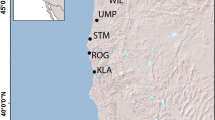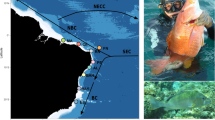Abstract
Determining the magnitude of homing behaviour within migratory fish species is essential for their conservation and management. We tested for population genetic structuring in the anadromous alosines, Alosa alosa and A. fallax fallax, to establish fidelity of stocks to spawning grounds in the United Kingdom and Ireland. Considerable genetic differences were present among populations of both species, suggesting strong fidelity to breeding grounds and compatible with homing to natal origins. Moreover, the genetic structure of A. fallax fallax showed a clear pattern of isolation-by-distance, consistent with breeding populations exchanging migrants primarily with neighbouring populations. Spatial genetic differences were on average much greater than temporal differences, indicating relatively stable genetic structure. Comparing anadromous A. fallax fallax populations to the landlocked Killarney shad subspecies, A. fallax killarnensis (Ireland), demonstrated a long history of separation. These results demonstrating regional stock structure within the British Isles will inform practical management of stocks and their spawning habitats.




Similar content being viewed by others
References
Alexandrino PJ, Ferrand N, Rocha J (1996) Genetic polymorphism of a haemoglobin chain and adenosine deaminase in European shads: evidence for the existence of two distinct genetic entities with natural hybridization. J Fish Biol 48:447–456
Alexandrino PJ, Faria R, Linhares D, Castro F, Le Corre M, Sabatié MR, Baglinière J-L, Weiss S (2006) Interspecific differentiation and intraspecific substructure in two closely related clupeids with extensive hybridization, Alosa alosa and Alosa fallax. J Fish Biol 69(Supp B):242–259
Aprahamian MW, Lester SM (2001) Variation in the age at first spawning of female twaite shad (Alosa fallax fallax) from the River Severn, England. Bull Français de la Pêche et de la Pisciculture 362(363):941–951
Aprahamian MW, Baglinière J-L, Sabatié MR, Alexandrino PJ, Thiel R, Aprahamian CD (2003a) Biology, status, and conservation of the anadromous Atlantic twaite shad Alosa fallax fallax. Am Fish Soc Symp 35:103–124
Aprahamian MW, Aprahamian CD, Baglinière J-L, Sabatié MR, Alexandrino PJ (2003b). Alosa alosa and Alosa fallax spp.: literature review and bibliography. RandD technical report W1-014/TR. Environment Agency, Bristol
Baglinière J-L, Sabatié MR, Rochard E, Alexandrino PJ, Aprahamian MW (2003) The allis shad Alosa alosa: Biology, ecology, range, and status of populations. Am Fish Soc Symp 35:85–102
Boisneau P, Menesson-Boisneau C, Guyomard R (1992) Electrophoretic identity between Allis shad, Alosa alosa (L.), and Twaite shad, Alosa fallax (Lacépède). J Fish Biol 40:731–738
Brookfield JFY (1996) A simple new method for estimating null allele frequency from heterozygote deficiency. Mol Ecol 5:453–455
Ciborowski KL, Consuegra S, Garcia de Leaniz C, Wang J, Beaumont M, Jordan WC (2007) Stocking may increase mitochondrial DNA diversity but fails to halt the decline of endangered Atlantic salmon populations. Cons Biol 8:1355–1367
Corander J, Marttinen P (2006) Bayesian identification of admixture events using multi-locus molecular markers. Mol Ecol 15:2833–2843
Cornuet JM, Luikart G (1996) Description and power analysis of two tests for detecting recent population bottlenecks from allele frequency data. Genetics 144:2001–2014
Coscia I, Rountree V, King JJ, Roche WK, Mariani S (2010) A highly permeable species boundary between two anadromous fishes. J Fish Biol 77:1137–1149
Doherty D, Maoleidigh NO, McCarthy TK (2004) The biology, ecology and future conservation of Twaite shad (Alosa fallax Lacépède), Allis shad (Alosa alosa L.) and Killarney shad (Alosa fallax killarnensis Tate Regan) in Ireland. Biol Environ Proc R Ir Acad 104B:93–102
Excoffier L, Laval G, Schneider S. (2005) Arlequin (version. 3.0): an integrated software package for population genetics data analysis. Evol Bioinform Online 1:47–50
Faria R, Wallner B, Weiss S, Alexandrino PJ (2004) Isolation and characterization of eight dinucleotide microsatellite loci from two closely related clupeid species (Alosa alosa and A. fallax). Mol Ecol Notes 4:586–588
Faria R, Weiss S, Alexandrino PJ (2006) A molecular phylogenetic perspective on the evolutionary history of Alosa spp. (Clupeidae). Mol Phylogenet Evol 40:298–304
Garcia de Leaniz C, Fleming IA, Einum S, Verspoor E, Jordan WC, Consuegra S, Aubin-Horth N, Lajus D, Letcher BH, Youngson AF, Webb JH, Vøllestad LA, Villanueva B, Ferguson A, Quinn TP (2007) A critical review of adaptive genetic variation in Atlantic salmon: implications for conservation. Biol Rev 82:173–211
Goudet J (1995) FSTAT (version 1.2): a computer program to calculate F- statistics. J Hered 86:485–486
Goudet J (1999) PCA-Gen version 1.2. Institute of Ecology, Biology Building, University of Lausanne (UNIL), Lausanne
Hall TA (1999) BioEdit: a user-friendly biological sequence alignment editor and analysis program for Windows 95/98/NT. Nucl Acids Symp Ser 41:95–98
Hasselman DJ (2008) Comments on ‘Weak population differentiation in northern European populations of the endangered anadromous clupeid Alosa fallax. J Fish Biol 73:1096–1098
Hasselman DJ, Bradford RG, Bentzen P (2010) Taking stock: defining populations of American shad (Alosa sapidissima) in Canada using neutral genetic markers. Can J Fish Aquat Sci 67:1021–1039
Hauser L, Carvalho GR (2008) Paradigm shifts in marine fisheries genetics: ugly hypotheses slain by beautiful facts. Fish Fish 9:333–362
Hendricks ML, Hoopes RL, Arnold DA, Kaufmann ML (2002) Homing of hatchery-reared American shad to the Lehigh River, a tributary to the Delaware River. N Am J Fish Manage 22:243–248
Jolly MT, Maitland PS, Genner MJ (2011) Genetic monitoring of two decades of hybridisation between allis shad (Alosa alosa) and twaite shad (Alosa fallax). Conserv Genet 12(4):1087–1100
Julian SE, Barton ML (2007) Microsatellite DNA markers for American shad (Alosa sapidissima) and cross-species amplification within the family Clupeidae. Mol Ecol Notes 7:805–807
King JJ, Roche WK (2008) Aspects of anadromous Allis shad (Alosa alosa Linnaeus) and Twaite shad (Alosa fallax Lacepede) biology in four Irish Special Areas of Conservation (SACs): status spawning indications and implications for conservation designation. Hydrobiologia 602:145–154
Landry C, Bernatchez L (2001) Comparative analysis of population structure across environments and geographic scales at Major Histocompatibility Complex and microsatellite in a philopatric fish (Salmo salar). Mol Ecol 10:2525–2540
Lassalle G, Trancart T, Lambert P, Rochard E (2008) Latitudinal variations in age and size at maturity among allis shad Alosa alosa populations. J Fish Biol 73:1799–1809
Librado P, Rozas J (2009) DNASP v5: software for comprehensive analysis of DNA polymorphism data. Bioinformatics 25:1451–1452
Limburg KE, Waldman JR (2009) Dramatic declines in North Atlantic diadromous fishes. Bioscience 59:955–996
Maes J, Stevens M, Breine J (2008) Poor water quality constrains the distribution and movements of twaite shad Alosa fallax fallax (Lacepede, 1803) in the watershed of river Scheldt. Hydrobiologia 602:129–143
Maitland PS, Hatton-Ellis TW (2003) Ecology of the Allis and Twaite Shad. Conserving natura 2000 rivers ecology series no. 3. English Nature, Peterborough
Maitland PS, Lyle AA (2005) Ecology of allis shad Alosa alosa and twaite shad Alosa fallax in the Solway Firth, Scotland. Hydrobiologia 534:205–221
Melvin GD, Dadswell MJ, Martin JD (1986) Fidelity of American shad, Alosa sapidissima (Clupeidae), to its river of previous spawning. Can J Fish Aquat Sci 43:640–646
O’Maoleidigh N, Cawdrey S, Bracken JJ, Ferguson A (1988) Morphometric, meristic character and electrophoretic analyses of two Irish populations of twaite shad, Alosa fallax (Lacepede). J Fish Biol 32:355–366
Palkovacs EP, Dion KB, Post DM, Caccone A (2008) Independent evolutionary origins of landlocked alewife populations and rapid parallel evolution of phenotypic traits. Mol Ecol 17:582–597
Pritchard JK, Stephens M, Donnelly PJ (2000) Inference of population structure using multilocus genotype data. Genetics 155:945–959
Rakaj N, Crivelli AJ (2001) Occurrence of agone Alosa agone in Lake Shkodra, Albania in sympatry with twaite shad Alosa fallax nilotica. B Fr Peche Piscic 362(363):1067–1073
Raymond M, Rousset F (1995) GENEPOP version 1.2: populations genetics software for exact tests and ecumenicism. J Hered 86:248–249
Regan CT (1912) The twaite shad in Killarney lakes. Ir Nat 21:63
Rousset F (2008) Genepop’007: a complete re-implementation of the genepop software for Windows and Linux. Mol Ecol Resour 8:103–106
Tajima F (1989) Statistical method for testing the neutral mutation hypothesis by DNA polymorphism. Genetics 123:585–595
Thiel R, Riel P, Neumann R, Winkler HM, Bottcher U, Grohsler T (2008) Return of twaite shad Alosa fallax (Lacepede, 1803) to the Southern Baltic Sea and the transitional area between the Baltic and North Seas. Hydrobiologia 602:161–177
Thorrold SR, Campana SE, Jones CM, McLaren JW, Lam JWH (1998) Trace element signatures in otoliths accurately record natal river of juvenile American shad (Alosa sapidissima). Limnol Oceanog 43:1826–1835
Trewavas E (1938) The Killarney Shad or Goureen (Alosa fallax killarnensis, Regan 1916). Proc Linn Soc Lond 150:110–112
van Oosterhout C, Hutchinson WF, Willis DPM, Shipley P (2004) MICRO-CHECKER: software for identifying and correcting genotyping errors in microsatellite data. Mol Ecol Notes 4:535–538
Volk J, Bekkevold D, Loeschcke V (2007) Weak population differentiation in northern European populations of the endangered anadromous clupeid Alosa fallax. J Fish Biol 71(Supp C):461–469
Waldman JR, Grunwald C, Wirgin I (2008) Sea lamprey Petromyzon marinus: an exception to the rule of homing in anadromous fishes. Biol Lett 6:659–662
Walther BD, Thorrold SR (2008) Continental-scale variation in otolith geochemistry of juvenile American shad (Alosa sapidissima). Can J Fish Aquat Sci 65:2623–2635
Waters JM, Epifanio JM, Gunter T, Brown BL (2000) Homing behaviour facilitates subtle genetic differentiation among river populations of Alosa sapidissima: microsatellites and mtDNA. J Fish Biol 56:622–636
Acknowledgments
We thank Jane Coghill and Keith Edwards from the Transcriptomics Facility at the University of Bristol for help with genotyping. This work was funded by the Esmee Fairbairn Foundation. MJG was supported by a Great Western Research Fellowship.
Author information
Authors and Affiliations
Corresponding author
Additional information
Communicated by M. I. Taylor.
Electronic supplementary material
Below is the link to the electronic supplementary material.
Rights and permissions
About this article
Cite this article
Jolly, M.T., Aprahamian, M.W., Hawkins, S.J. et al. Population genetic structure of protected allis shad (Alosa alosa) and twaite shad (Alosa fallax). Mar Biol 159, 675–687 (2012). https://doi.org/10.1007/s00227-011-1845-x
Received:
Accepted:
Published:
Issue Date:
DOI: https://doi.org/10.1007/s00227-011-1845-x




